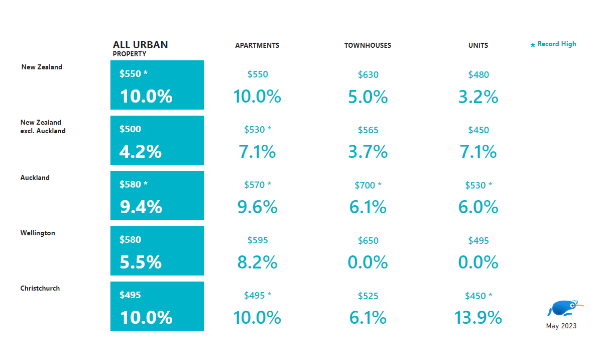PHOTO: Trade Me
Trade Me’s Rental Price Index for May shows New Zealand’s median weekly rental prices claim another record high for 2023.
propertynoise.co.nz to launch real estate industry recruitment site
Three months after reaching $600 for the first-time, the median weekly rent rose again to hit $610 in May. This means tenants are paying an extra $35 a week or $1,820 more a year than in 2022, Trade Me’s Director of Property Sales Gavin Lloyd said.
“It appears that after the large pay increases we saw throughout 2022, landlords are still feeling confident to ask for more. But we expect rents to taper off later in the year as landlords respond to stalling wages and tenants lack of disposable income. Until then, renters’ wallets will feel the pain,” Mr Lloyd said.
“We’re also seeing the market impacted by changes to Government tax policies, and higher interest rates.”

The regional snapshot
Regional Aotearoa saw some feverish rental price rises in May.
The Taranaki region had the highest year-on-year median weekly rent rise. At $620 it rose by $80 a week from May 2022. The median weekly rental price there had steadily risen since November.
“That’s an extra $4,160 a year people in Taranaki are paying in rent compared to last May,” Mr Lloyd said.
The Queenstown-Lakes district, which had a relatively small number of listings, had a median weekly rent of $750, up $150 from May 2022 when it was $600. The last time Queenstown-Lakes district had a median weekly rental price of $750 was in February 2020, when covid was starting to make waves globally.
“Being a tourist mecca, Queenstown-Lakes has been at the mercy of the pandemic. Prices in the district fell away substantially while the borders were closed and the number of people visiting and living there plummeted. However, as tourism ramps back up in Queenstown-Lakes, rental prices for the district are rising again,” Mr Lloyd said.

Auckland’s flooding woes
Auckland rose $60 per week to $660 in May, claiming the title of the region with the highest median weekly rental price.
Supply of rental properties in the Auckland region saw a 35 per cent drop from last year, while demand was up 55 per cent year-on-year.
“After the widespread damage caused by the flooding earlier this year, we expected that prices would rise as the region battled with supply issues,” Mr Lloyd said.
propertynoise.co.nz to launch real estate industry recruitment site
Auckland’s urban properties – apartments, townhouses and units – all hit record median weekly rental prices in May. Apartments are sitting at $570 per week, units are $530, and townhouses are $700.
“This is what typically happens – when properties get more expensive, people look to cheaper places they can live in, and that’s usually smaller places like the urban properties.”

The squeeze on rental properties
Across the motu, the supply, or the number of properties available to rent in May was down 19 per cent from May 2022, while demand was up 35 per cent.
“There was a general lack of supply of rental properties in most places and there were a number of factors driving this,” Mr Lloyd said.
“During Covid, with the collapse of tourism and migration, we saw people pull their short-term rentals, and place those properties into the long-term rental market. What’s playing out now is the reversal of that. People are moving their properties back into the tourism market where they can make money with fewer obligations on them,” Mr Lloyd said.
However, not all regions suffered from a lack of supply. Northland had a massive 45 per cent increase in the number of listings onsite from May 2022, the Manawatū/Whanganui spiked up 44 per cent, and the Nelson/Tasman region rose 20 per cent.
Got an interesting property related story?














